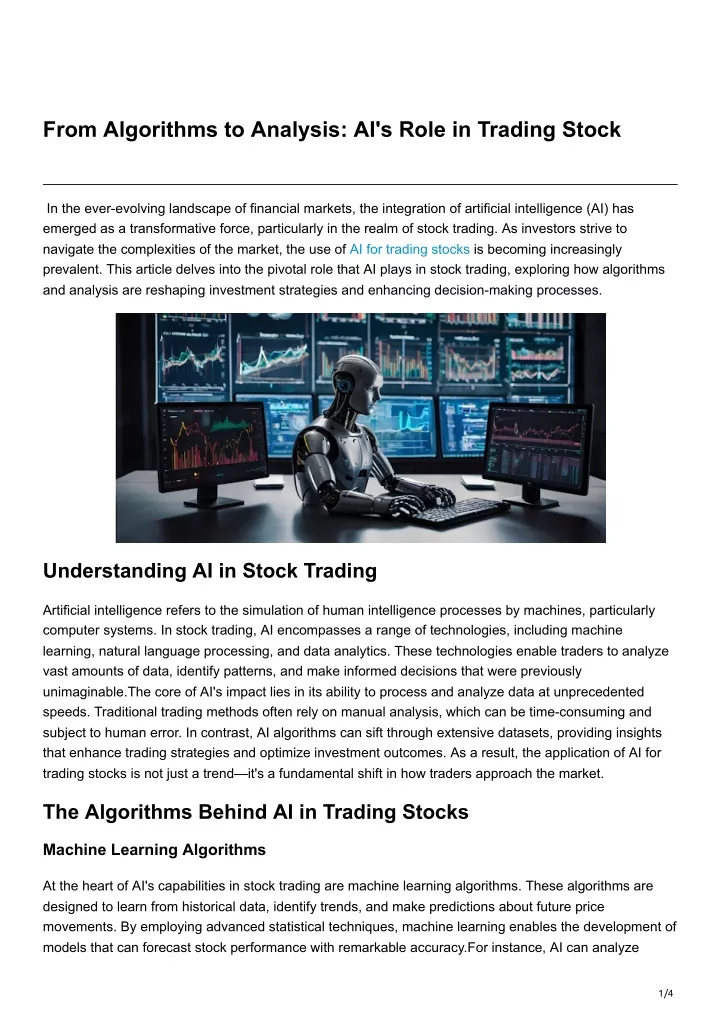20 New Reasons For Selecting AI Stock Trading Platform Sites
20 New Reasons For Selecting AI Stock Trading Platform Sites
Blog Article
Top 10 Ways To Evaluate The Integration And Compatibility Of Ai-Based Stock Predicting/Analyzing Trading Platforms
When you are evaluating AI trading platforms compatibility and integration are key elements. Platforms that are compatible with existing tools, workflows, and systems can enhance efficiency and productivity. These are the top 10 tips to evaluate the compatibility and integration of these platforms:
1. Check Brokerage Integration
Brokers that are supported: Make sure the platform integrates with your preferred brokerage or trading account.
Trade execution: Check if the platform allows direct trade execution via the broker integrated.
Account synchronization: Verify that the platform is able to sync in real time accounts, balances and positions and transaction history.
2. Check API availability
API access - Check that the platform comes with an API that allows developers to develop customized tools or automate workflow processes.
API documentation: Check for examples of how the API is used.
Rate limits: Find out the appropriate rates for the API and if it can accommodate the anticipated volume of usage.
3. Assess Third-Party Tool Integration
Popular Tools: Make sure that the platform is compatible with other software, like Google Sheets and Excel.
Export and import of data. Be sure the platform is able to easily export or import from or to any other tool.
Plugins/extensions : Verify the platform is able to support plugins or extensions. They add features.
4. Test Compatibility Using Operating Systems
Desktop compatibility: Make sure the device is compatible with the operating system of choice (Windows, macOS or Linux).
Mobile compatibility - Look to see if the platform has a mobile app available for iOS as well as Android.
Web-based accessibility: To enhance flexibility, verify that the platform's interface is accessible through a web browser.
5. Analyze Data Integration Capabilities
Data sources: Make sure that the platform integrates with various data sources (e.g. market data sources, news feeds, sentiment on social media).
Real-time analytics: Make sure the platform integrates real-time analyses.
Import historical data - Make sure whether the platform permits you to add historical data to your backtesting software or analysis software.
6. Testing of cloud and on-premise compatibility
Cloud-based platforms: Ensure the platform is available from any location with an internet connection.
On-premises deployment: Find out if the platform you're using supports deployment on premises.
Hybrid models: Find out whether the cloud-based platform integrates and on-premise capabilities.
7. Check for Cross Platform Syncronization
Device synchronization - Ensure that your platform is synchronized to sync settings and data across all devices (desktops mobiles, tablets, desktops).
Real-time updates: See if your changes made on one device instantly show up on the other devices.
Examine the platform to determine whether it permits data or functionality access even when you are offline.
8. Analyzing the compatibility of trading strategies
Algorithmic trading: Ensure the platform supports algorithms or automated trading strategies.
Custom indicators: Find out whether you are allowed to use custom indicators or scripts.
Strategy backtesting: Determine if the platform supports backtesting of trading strategies using historical data.
9. Examine Security and Compliance
Data encryption: Verify that the platform uses encryption to secure data during transit and in rest.
Verify that the platform supports secure methods for authentication (e.g. Two-factor authentication).
Regulatory Compliance: Check if your platform is compliant with the applicable regulations.
10. Test Scalability and Performance
Scalability: Ensure the platform can handle growing amounts of data and users as your needs grow.
Performance during load: Determine whether the platform performs as expected in high-volatility situations.
Resource usage - Check whether the platform is using the resources of the system, such as CPU, memory or bandwidth.
Bonus Tips
User feedback: Research user reviews and testimonials to evaluate the capabilities of the platform to integrate.
Trial period: Try the platform for free, or download a demo to see how it integrates with your existing tools and workflows.
Customer support: Check that the platform has robust assistance in the event of integration problems.
Check these suggestions to determine the compatibility and integration between AI platforms for predicting and analyzing stocks as well as your trading systems in place, and make sure they improve the efficiency of your trading. Have a look at the top rated chart ai trading assistant for website recommendations including ai for stock predictions, ai stock trading bot free, options ai, ai stock trading, trading with ai, chart ai trading assistant, trading ai, ai investing app, trading ai, trading ai and more.
Top 10 Tips For Evaluating The Transparency Of Ai Stock Predicting/Analyzing Trading Platforms
Transparency can be an important factor when it comes to the evaluation of AI trading and stock prediction platforms. Transparency allows users to be sure of the operations of the platform, make decisions, and verify accuracy of predictions. These are the top 10 methods to assess the degree of transparency on such platforms.
1. A clear explanation of AI Models
Tip: Check if the platform has an explanation of the AI models, algorithms and platforms that are used.
Knowing the technology behind it lets users evaluate its credibility.
2. Disclosure of Data Sources
TIP: Make sure the platform discloses the data sources it uses (e.g. historical stock data, social media).
The reason: Understanding the sources of data will ensure that the platform has reliable and complete data.
3. Performance Metrics and Backtesting Results
Tips: Look for reports that are transparent of performance metrics.
How do users determine the efficiency of an application by examining its past performance.
4. Updates and notifications in real-time
TIP: Determine if the platform provides real-time updates and notifications about trading, predictions, or system changes.
What is the reason? Real-time transparency means users are always aware of critical actions.
5. Limitations - Open communication
TIP: Find out if the platform is openly discussing the limitations and risks of its predictions and trading strategies.
The reason: Recognizing limitations increases confidence and allows users to make educated decisions.
6. Users can access raw data
Tip: Find out if you have access to the raw data, or the intermediate results AI models utilize.
Why? Because the raw data is accessible to the user for their personal analysis.
7. Transparency in Costs and Fees
Check that the platform clearly states all fees for subscriptions and any hidden costs.
Transparent Pricing: It builds trust by preventing costs that are unexpected.
8. Regular reporting and audits
Verify if a platform has regular reports and goes through third party audits in order to check the efficiency of its operation.
Independent verification is crucial as it increases the credibility of the process and ensures accountability.
9. Explainability in Predictions
Tips: Make sure the platform offers information about how recommendations or predictions (e.g. the importance of features or decision tree) are generated.
Why is this? Explainability allows users to learn the reasoning behind AI-driven actions.
10. User Feedback and Support Channels
Tips: Make sure the platform provides open channels to get feedback from users and offers assistance. Also, you should determine if it addresses user concerns in a manner that is transparent.
Why? Responsive communication demonstrates an interest in transparency and user satisfaction.
Bonus Tip: Regulatory Compliance
Check that the platform is in compliance and is transparent about its compliance with financial regulations. This adds an additional level of transparency.
When you evaluate these functions, you can decide whether or not an AI trading platform and stock prediction are transparent. It will then be able to make well-informed decisions and have confidence in its abilities. Take a look at the top invest ai recommendations for blog tips including best stock prediction website, best stock prediction website, best stock prediction website, stock trading ai, best ai for stock trading, trading ai tool, stocks ai, invest ai, ai in stock market, best ai penny stocks and more.